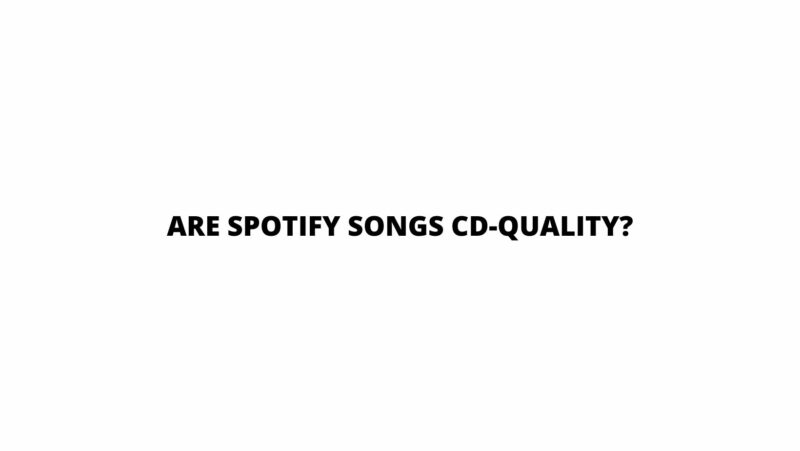In the realm of modern music consumption, streaming services have risen to prominence, offering users unparalleled access to a vast library of songs. Spotify, as one of the giants in this arena, has attracted millions with its convenience and diversity. However, a lingering question prevails: Are Spotify’s songs truly CD-quality? In an era where audio fidelity is cherished by audiophiles and enthusiasts, this article delves into the intricacies of Spotify’s audio quality, dissecting the factors that shape its sonic output and uncovering whether it genuinely rivals the pristine sound quality of Compact Discs (CDs).
Understanding CD-Quality
Before embarking on the comparison, it’s vital to understand the benchmarks of CD-quality audio. CDs offer uncompressed audio with a sample rate of 44.1 kHz and a bit depth of 16 bits. This format, widely considered a gold standard for audio quality, captures the richness, dynamic range, and depth of musical performances with remarkable fidelity.
Spotify’s Audio Quality Tiers
Spotify, catering to a diverse user base with varied connectivity and audio preferences, offers multiple audio quality tiers:
- Normal (96 kbps): Designed for users with limited data or slower internet connections, this tier provides basic audio quality but sacrifices some detail due to the lower bitrate.
- High (160 kbps): Striking a balance between audio quality and data consumption, the high-quality tier offers an improved listening experience suitable for most users.
- Very High (320 kbps): Considered by many to be the closest match to CD-quality, this tier is favored by audiophiles and those who prioritize superior audio fidelity.
Compression: The Achilles’ Heel
Spotify’s audio quality hinges on the delicate balance between compression and audio fidelity. Compression is a process that reduces the file size of audio tracks by removing redundant or less perceptible information. While effective compression can significantly reduce file sizes without a drastic loss in quality, it’s an art that requires a meticulous approach.
Lossy vs. Lossless Compression
Spotify employs lossy compression for its audio streaming, aiming to strike a balance between audio quality and data efficiency. Lossy compression discards audio data that might be less perceptible to the human ear, reducing file sizes while attempting to retain acceptable sound quality. This is in contrast to lossless compression formats like FLAC or ALAC, which maintain all the original audio data without any loss, resulting in larger file sizes.
The Bitrate Dilemma
Bitrate plays a pivotal role in determining audio quality. It refers to the number of bits of data processed per unit of time and is often used as a measure of audio quality in compressed formats. While Spotify’s highest quality tier (320 kbps) may seem comparable to CD-quality, it’s essential to recognize that compression algorithms and the audio’s source quality influence how effectively that bitrate translates into audio fidelity.
The Impact of Source Material
The source material—the original recording from which the audio is derived—plays a vital role in determining the audio quality of any format. If the source material lacks detail, dynamic range, or was poorly recorded, even the highest quality streaming may not match the richness of CD-quality sound.
Listening Experience and Subjective Perception
Assessing audio quality involves both objective analysis and subjective perception. Objective measurements, such as frequency response graphs and dynamic range calculations, provide technical insights. However, the listening experience is inherently subjective, influenced by individual preferences, environmental factors, and emotional engagement.
Audiophile Evaluation and Challenges
Audiophiles, who demand the utmost audio quality, often subject Spotify’s offerings to rigorous evaluations. A/B testing—comparing CD-quality audio with Spotify’s Very High quality—can yield insights. However, even audiophile ears sometimes struggle to consistently discern minute differences, raising questions about the threshold at which differences become perceptible.
User Preference and Accessibility
While audio quality is paramount to audiophiles, the average listener’s preferences often vary. Many listeners prioritize accessibility, portability, and the sheer convenience of streaming over minute differences in sound quality. Streaming’s advantage lies in its ability to cater to the broader audience, accommodating a spectrum of preferences.
Conclusion
The question of whether Spotify songs are truly CD-quality demands a nuanced understanding of compression, bitrates, source material, and the dynamics of perception. Spotify’s highest quality tier offers a commendable listening experience, particularly to the average listener, and is a far cry from the low-bitrate audio formats of the past.
For the discerning audiophile, the distinction between CD-quality and the best that Spotify has to offer might be discernible in controlled listening environments. However, the reality remains that the margin of difference has narrowed considerably, allowing for a broader acceptance of high-quality streaming.
In the ever-evolving landscape of music consumption, both CDs and Spotify represent distinct paradigms, each with its unique merits. As technology continues to refine audio compression techniques and enhance streaming quality, the gap between CD-quality and Spotify’s best continues to shrink, ultimately enriching the sonic experiences of music enthusiasts across the globe.


